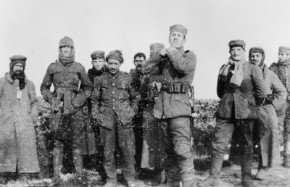Christmas truce

And suddenly there was with the angel a multitude of the
heavenly host, praising God and saying,
“Glory to God in the highest heaven,
and on earth peace among those whom he favors!”
The words strike deeply in our hearts whether recited by a child, sung by a choir, or inscribed on a greeting card. Yet peace on earth and goodwill among humans is remote. In fact, it sometimes seems that hoping for peace, expecting peace, and praying for peace is a hopeless human project.
Read our latest issue or browse back issues.
This year marked the 100th anniversary of the beginning of the First World War. As the first mechanized war, its cost in human life was enormous and horrifying. It was to have been “the war to end all wars,” but the height of tragic irony is that it was merely a prelude to a greater, more lethal war, followed by uninterrupted violence, suffering, and tragedy in the next century. Are we naive to keep talking about and hoping and praying for peace?
The Christmas truce of 1914 gave the world a glimpse of peace in a horrific time. On Christmas Eve of that year, two great armies faced each other across a front that extended along the French-Belgian border. Troops crouched in trenches cut into the soggy soil, with only candles, lanterns, and flashlights to give them light. It was a constant struggle to keep the mud walls from collapsing and the trenches from flooding.
Between the trenches was 50 to 100 yards of “no man’s land.” Snipers posted on each side had orders to shoot anything that moved in the opposite trench. Hand grenades were thrown, artillery shells lobbed, and occasionally soldiers charged up out of the trenches.
As Christmas approached, troops on both sides received packages from home. British troops received Princess Mary Packets—cigarettes, a greeting card from King George V, an individual plum pudding, and Cadbury chocolates. A German package included tobacco and a pipe, a profile of Crown Prince Frederick Wilhelm, and sausages and beer. The German government also sent bundles of Christmas trees to the front.
On December 24 the shooting began to slow down and then stopped altogether. No orders were given. Combatants simply stopped shooting at one another. In the early evening British troops were startled to see Christmas trees with lighted candles on the parapets of the German trench. In one spot, a German voice called out: “A gift is coming now.” The British dove for cover, expecting a grenade. What came across was a boot filled with sausages. The British troops responded by sending a plum pudding and a greeting card from the king.
Then singing started: patriotic and military songs at first, followed by applause from the opposite trench. Then, breaking an eerie silence, the Germans sang “Stille Nacht, Heilige Nacht,” and the British joined in, all up and down the front, on “Silent Night, Holy Night.”
On Christmas Day opposing troops ventured out to extend greetings, awkward handshakes, and small gifts. In several places soccer games were played.
After a week or so the shooting resumed, and there were 6,000 deaths each day for the next 46 months.
Stanley Weintraub recounts this incident in Silent Night: The Story of the World War I Christmas Truce. He reflects: “The Christmas Truce has lingered strikingly in the memory . . . [it] remains a potent symbol of stubborn humanity within us.”
The Christmas truce is almost too good to be true, and yet it is no more unrealistic than the angel announcing that a newborn baby is the Savior. And it is no more naive than our faith that the birth means that peace is always possible, and even close at hand.






